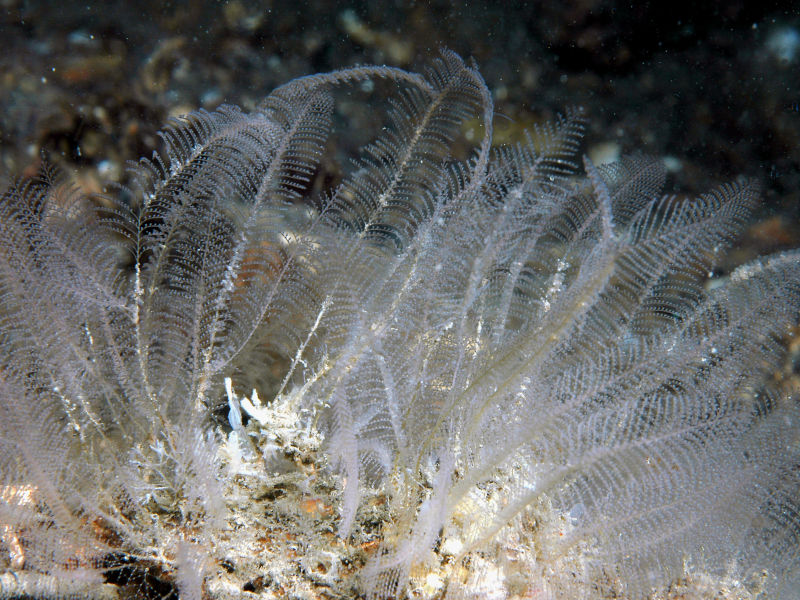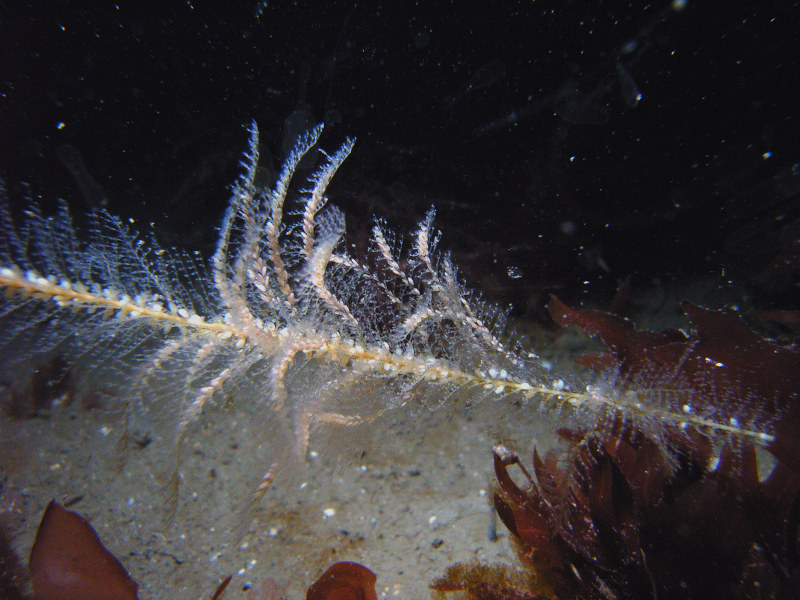Glassy plume hydroid (Plumularia setacea)
Distribution data supplied by the Ocean Biodiversity Information System (OBIS). To interrogate UK data visit the NBN Atlas.Map Help
| Researched by | Kelsey Lloyd | Refereed by | Admin |
| Authority | (Linnaeus, 1758) | ||
| Other common names | - | Synonyms | - |
Summary
Description
A feather-like sea fir forming a flat two-dimensional plane that can grow up to 1.5 cm on other species but up to 7 cm on rocks and boulders. The main stem is brown in colour, slightly winding, with long side branches attached. Long internodes of the main stem bear polyps in chitinous cups (hydrothecae) with two or three nodes between each one and its neighbour. It bears both male and female reproductive polyps (gonothecae) that are a distinctive ampule shape.
Recorded distribution in Britain and Ireland
Widespread around British Isles and east coast of Ireland. Less common on the east coast of Scotland and north-eastern coast of England.
Global distribution
Plumularia setacea is nearly cosmopolitan in tropical to temperate coastal waters. It is recorded in the north-east Atlantic Ocean, from Iceland and Norway and south to the Mediterranean and Black Sea.
Habitat
Plumularia setacea is commonly found in intertidal and coastal habitats. It is recorded on algae, pool sides and rock faces on the shore, and on a variety of substrata. It is thought to prefer Nemertesia ramosa, Nemertesia antennina, sponges, ascidians, molluscs and plants.
Depth range
Usually lower shore to 90 m but can be found down to 604 mIdentifying features
- Colony pinnate with an erect stem, usually single plume but occasionally repeatedly branched and multi-plumed.
- Long side branches alternate along the main stem to 2.5 cm in length.
- Central main stem is brown in colour.
- Hydrothecae are short and wide with an even rim.
- Gonothecae form a neat continuous line down the central stem with an oval body and tubular neck.
- The male gonothecae are narrower and smaller than the female, and are found lower down on the colony.
Additional information
Plumularia setacea is apparently intolerant of reduced salinity (Cornelius, 1995b).
Listed by
- none -
Bibliography
- Schuchert, P., 2014. High genetic diversity in the hydroid Plumularia setacea: A multitude of cryptic species or extensive population subdivision? Molecular Phylogenetics and Evolution, 76, 1-9. DOI https://doi.org/10.1016/j.ympev.2014.02.020
Cornelius, P.F.S., 1995b. North-west European thecate hydroids and their medusae. Part 2. Sertulariidae to Campanulariidae. Shrewsbury: Field Studies Council. [Synopses of the British Fauna no. 50]
Hayward, P., Nelson-Smith, T. & Shields, C. 1996. Collins pocket guide. Sea shore of Britain and northern Europe. London: HarperCollins.
Hayward, P.J. & Ryland, J.S. (ed.) 1995b. Handbook of the marine fauna of North-West Europe. Oxford: Oxford University Press.
Hayward, P.J. & Ryland, J.S. (ed.) 2017. Handbook of the marine fauna of North-West Europe. Oxford: Oxford University Press.
Porter, J., 2012. Seasearch Guide to Bryozoans and Hydroids of Britain and Ireland. Ross-on-Wye: Marine Conservation Society.
Datasets
Citation
This review can be cited as:
Last Updated: 30/09/2021
- Sea fir
- Hydroid




